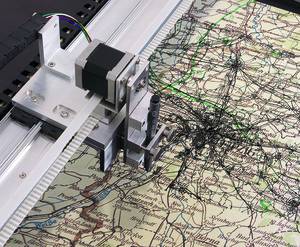Quadrature
Jan Bernstein *1982, Juliane Götz *1984, Sebastian Neitsch *1982
Ausstellungen (Auswahl) / Exhibitions (selection):
The Informed Body - Node 15, Frankfurt, DE / TADAEX 04 - Tehran Annual Digital Art Exhibition, Tehran, IR / Kunststiftung Sachsen-Anhalt, Halle/Saale, DE / Audio Visual Performance - Visions of America: Amérique, Walt Disney Concert Hall, Los Angeles, USA / Theater Performance - CIA (with Wojtek Ziemilski), EMPAC, Troy, Upstate New York, USA
Kartograph (2015)

Zeichenmaschine (Karten, Stift, Stahl, Aluminium, Holz, Schrittmotoren, Elektronik)
Kartograph aktualisiert altes Kartenmaterial, indem die Maschine mithilfe des Internets neue Kartendaten über die Infrastruktur aus vergangenen Zeiten zeichnet. Die Auswahl des Ausschnitts basiert dabei auf dem Standort der Maschine.
Als Ausgangsmaterial werden alte Atlanten oder Karten verwendet, welche sehr lange Zeit die mitunter einzigen Nachschlagewerke für Informationen über nahe und ferne Länder waren. Ihre Aufgabe wurde im Laufe der letzten drei Jahrzehnte mehr und mehr von Onlinediensten wie Google Maps oder OpenStreetMap übernommen. Während klassische Papierkarten letztlich im Moment der Veröffentlichung bereits wieder veraltet sind, können sich die digitalen Kartendienste einfach ständig erneuern. Dieser Vorteil gegenüber dem Analogen reduziert das Objekt aber auf den reinen Informationsgehalt und vernachlässigt alle weiteren Bedeutungsebenen, die gerade Karten als Abbilder des Verständnisses von der Welt für unsere Kultur enthalten.
Davon unbeeindruckt überschreibt Kartograph die alten Quellen und zeigt so nicht nur die strukturellen Veränderungen, die in dem Gebiet seit dem Erscheinen der gedruckten Karten stattgefunden haben, sondern auch den Wandel der gesellschaftlichen und technischen Systeme.
Drawingmachine (maps, pen, steel, aluminium, wood, multiphase motors, electronics)
Kartograph is a machine that updates old maps by drawing new geographic data over the infrastructure of old times using the internet. The selection of the section is based on the location of the machine. The starting material are old atlases and maps that conceivably used to be the main source of knowledge for information regarding countries near or far. Their purpose was taken over more and more by online services like Google Maps or OpenStreetMap in the last three decades. While classic paper maps are basically already outdated the moment they get published, digital map services stay valid by simply updating themselves instantly. But this advantage over the analogue reduces the object to its mere informational value and disregards all the other levels of meaning that especially maps contain as reflections of the image we have of the world as a culture. Unimpressed by this, Kartograph overwrites the old source and thus not only demonstrates the structural changes that took place in this area since the printing of the original map but also the shift of technical systems and its social implementations.



